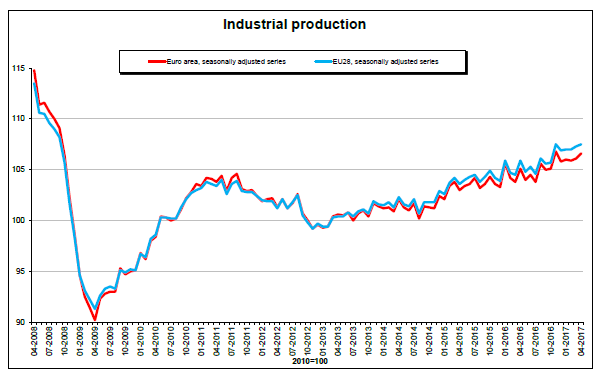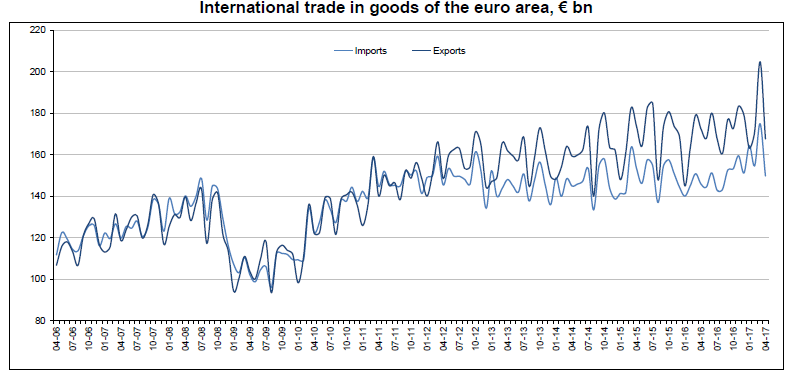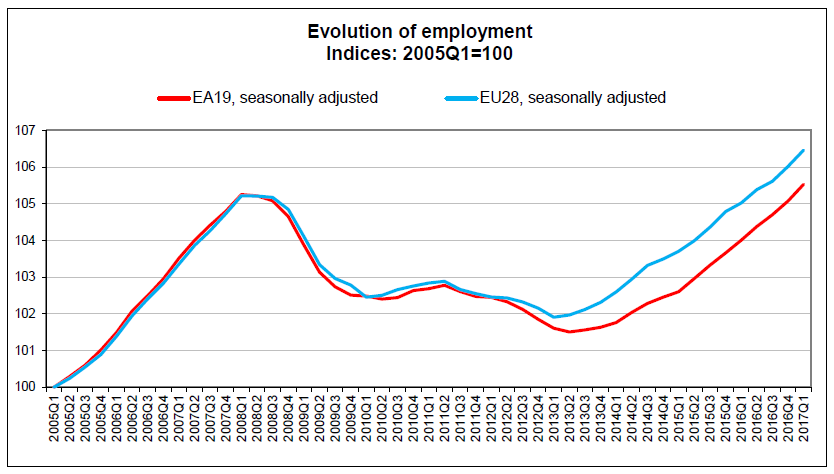McGeever, Jamie, (2017), “If central banks can’t taper QE now, when can they? Maybe never”, Reuters, 13 June As the Fed prepares to raise interest rates again and actively considers how and when to start exiting QE, it appears that the process of normalising monetary policy across the Western world is slowly but surely getting into gear. Global conditions for unwinding crisis-fueled stimulus look fertile: the strongest economic growth in …Read More
Industrial production up by 0.5 % in euro area
Eurostat/Industrial production up by 0.5% in euro area/14 June 2017 In April 2017 compared with March 2017, seasonally adjusted industrial production rose by 0.5% in the euro area (EA19) and by 0.2% in the EU28, according to estimates from Eurostat, the statistical office of the European Union. In March 2017 industrial production rose by 0.2% in euro area and by 0.3% in the EU28. In April 2017 compared with April …Read More
Euro area international trade in goods surplus €17.9 bn
Eurostat/Euro area international trade in goods surplus €17.9 bn/15 June 2017 The first estimate for euro area (EA19) exports of goods to the rest of the world in April 2017 was €167.7 billion, a decrease of 3% compared with April 2016 (€172.5 bn). Imports from the rest of the world stood at €149.8 bn, a rise of 3% compared with April 2016 (€145.9 bn). As a result, the euro area …Read More
How Long Can the Eurozone Survive Without Greater Integration?
Rogoff, Kenneth, (2017), “How Long Can the Eurozone Survive Without Greater Integration?”, Project Syndicate, 14 June With a reform-minded centrist president elected in France and the re-election of German Chancellor Angela Merkel seeming ever more likely, is there new hope for the stalled single-currency project in Europe? In the near term, it looks that way. The eurozone recovery has out-performed expectations, and the election of Macron has raised hopes that …Read More
Employment up by 0.4% in both the euro area and in the EU28
Eurostat/Employment up by 0.4% in both the euro area and in the EU28/14 June 2017 The number of persons employed increased by 0.4% in both the euro area (EA19) and in the EU28 in the first quarter of 2017 compared with the previous quarter, according to national accounts estimates published by Eurostat, the statistical office of the European Union. In the fourth quarter of 2016, employment increased also by 0.4% …Read More
Global Economic Outlook, June 2017
OECD, (2017), “Global Eonomic Outlook”, June The mood in the global econom has brightened during the lat year. Confidence indicators, industrial production, headline measures of employment, and cross-border trade flows have improved in most economies, However, this still-modest cyclical expansion is not yet robust enough to yield a durable improvement in potential output or to reduce persistent inequalities. Relevant Posts OECD, (2017), “Greece Economic Forecast (June 2017)”, June International Monetary …Read More
The macroeconomic impact of the ECB’s expanded asset purchase programme (APP)
Gambetti, Luca, Musso, Alberto, (2017), “The macroeconomic impact of the ECB’s expanded asset purchase programme (APP)”, ECB Working Paper Series No 2075, Ιούνιος This paper provides empirical evidence on the macroeconomic impact of the expanded asset purchase programme (APP) announced by the European Central Bank (ECB) in January 2015. The shock associated to the APP is identified with a combination of sign, timing and magnitude restrictions in the context of …Read More
Jobs gap closes but recovery remains uneven
OECD, (2017), “Jobs gap closes but recovery remains uneven”, 13 June The job market continues to improve in the OECD area, with the employment rate finally returning to pre-crisis levels. But people on low and middle incomes have seen their wages stagnate and the share of middle-skilled jobs has fallen, contributing to rising inequality and concerns that top earners are getting a disproportionate share of the gains from economic growth, …Read More
House prices and monetary policy in the euro area: evidence from structural VARs
Nocera, Andrea, Roma, Moreno, (2017), “House prices and monetary policy in the euro area: evidence from structural VARs”, ECB, June We use a structural Bayesian vector autoregression model for seven euro-area countries (Belgium, France, Germany, Ireland, Italy, the Netherlands, and Spain) for the period 1980:Q1- 2014:Q4 to provide a systematic structural analysis of the impacts of housing demand shocks on economic activity and the role of house prices in the monetary …Read More
Capital Requirements For Banks Are Needed But Costly—Only Limited Increases Are Called For
William R., Cline, (2017), “Capital Requirements For Banks Are Needed But Costly—Only Limited Increases Are Called For”, PIIE, 12 June Cline’s study, one of several analyses of financial stability published by PIIE since the crisis of 2008–09, reviews the extensive literature on banking crises, regulations, and their impact on capital formation and economic growth. It looks indepth at the multilateral voluntary framework on bank capital adequacy known as Basel III, established …Read More







